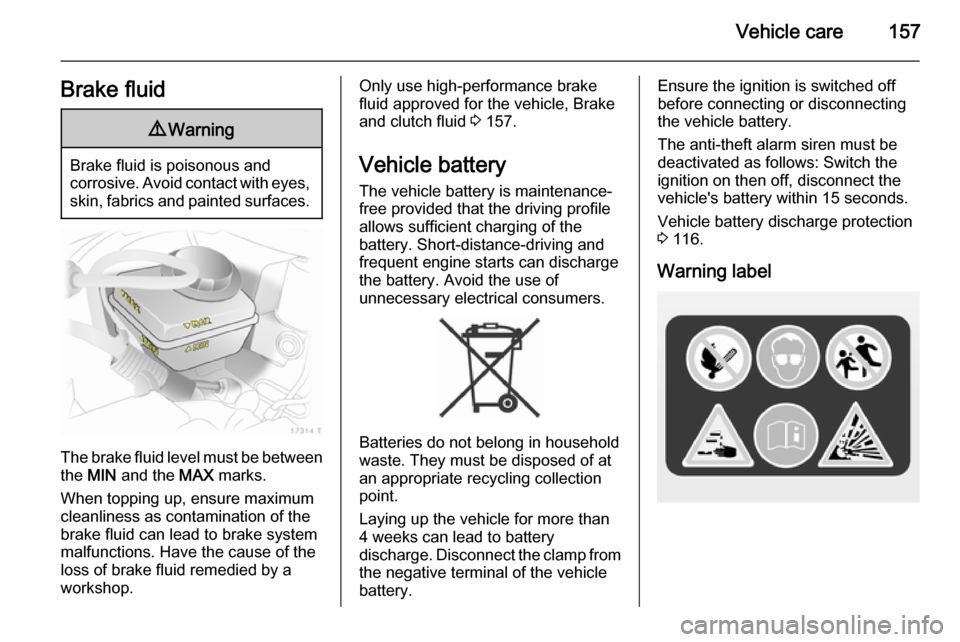maintenance VAUXHALL ZAFIRA 2014.5 Owner's Manual
[x] Cancel search | Manufacturer: VAUXHALL, Model Year: 2014.5, Model line: ZAFIRA, Model: VAUXHALL ZAFIRA 2014.5Pages: 219, PDF Size: 7.83 MB
Page 3 of 219

Introduction.................................... 2
In brief ............................................ 6
Keys, doors and windows ............25
Seats, restraints ........................... 43
Storage ........................................ 68
Instruments and controls .............78
Lighting ...................................... 109
Climate control ........................... 117
Driving and operating .................125
Vehicle care ............................... 152
Service and maintenance ..........193
Technical data ........................... 197
Customer information ................209
Index .......................................... 212Contents
Page 5 of 219

Introduction3Vehicle specific data
Please enter your vehicle's data on
the previous page to keep it easily
accessible. This information is
available under the sections "Service
and maintenance" and "Technical
data" as well as on the identification
plate.
Introduction
Your vehicle is a designed
combination of advanced technology, safety, environmental friendliness
and economy.
This Owner's Manual provides you
with all the necessary information to
enable you to drive your vehicle
safely and efficiently.
Make sure your passengers are
aware of the possible risk of accident
and injury which may result from
improper use of the vehicle.
You must always comply with the
specific laws and regulations of the
country that you are in. These laws
may differ from the information in this Owner's Manual.When this Owner's Manual refers to aworkshop visit, we recommend your
Vauxhall Authorised Repairer.
All Vauxhall Authorised Repairers provide first-class service at
reasonable prices. Experienced
mechanics trained by Vauxhall work
according to specific Vauxhall
instructions.
The customer literature pack should
always be kept ready to hand in the
vehicle glovebox.
Using this manual ■ This manual describes all options and features available for this
model. Certain descriptions,
including those for display and
menu functions, may not apply to
your vehicle due to model variant,
country specifications, special
equipment or accessories.
■ The "In brief" section will give you an initial overview.
■ The table of contents at the beginning of this manual and withineach section shows where the
information is located.■ The index will enable you to search
for specific information.
■ Yellow arrows in the illustrations serve as points of reference or
indicate some action to be
performed.
■ Black arrows in the illustrations indicate a reaction or a second
action to be performed.
■ This Owner's Manual depicts left- hand drive vehicles. Operation is
similar for right-hand drive vehicles.
■ The Owner's Manual uses the factory engine designations. The
corresponding sales designations
can be found in the section
"Technical data".
■ Directional data, e.g. left or right, or
front or back, always relate to the
direction of travel.
■ The vehicle display screens may not support your specific language.
■ Display messages and interior labelling are written in bold letters.
Page 38 of 219

36Keys, doors and windows
During the first 10 seconds of anti-
theft alarm system activation:LED illu‐
minates=Test, ignition delay,LED
flashes
quickly=Door, load
compartment or bonnet open, or system fault.
After the first 10 seconds of anti-theft
alarm system activation:
LED flashes
slowly=System active,LED comes on for approx. 1 second=Switch off
function.
Seek the assistance of a workshop in
the event of faults.
Deactivation
Unlocking the vehicle deactivates the anti-theft alarm system.
Alarm When triggered, the alarm gives off
an acoustic signal (horn) and a visual
signal (hazard warning flashers). The number and duration of which are
stipulated by legislation.
The alarm siren can be silenced by
pressing a button of the radio remote control or by switching on the ignition.
The anti-theft alarm system can be
deactivated only by pressing button
p or by switching on the ignition.
If the vehicle's battery is to be
disconnected (e.g. for maintenance
work), the alarm siren must be
deactivated as follows: switch the
ignition on then off, then disconnect
the vehicle's battery within
15 seconds.
Immobiliser The system checks whether the
vehicle is allowed to start with the key
being used. If the transponder in the
key is recognised, the engine can be
started.
The immobiliser is going to be
activated automatically after the key
has been removed from the ignition
switch or when the engine is switched
off by pressing the Start/Stop button.
Control indicator A 3 89.Notice
The immobiliser does not lock the
doors. You should always lock the
vehicle after leaving it and switch on the anti-theft alarm system 3 30,
3 34.
Page 119 of 219

Climate control117Climate controlClimate control systems ............. 117
Air vents ..................................... 123
Maintenance .............................. 124Climate control systems
Heating and ventilation
system
Controls for: ■ Air distribution
■ Temperature
■ Fan speed
Heated rear window Ü 3 41.
Air distribution
L=to head area and foot wellM=to head areal=to windscreen and front door
windowsJ=to windscreen, front door
windows and foot wellK=to foot well
Intermediate settings are possible.
Temperature
red=warmblue=cold
Heating will not be fully effective untilengine has reached normal operating temperature.
Fan speed Adjust the air flow by switching the fan
to the desired speed.
Demisting and defrosting the
windows ■ Set air distribution control to l.
■ Set temperature control to warmest
level.
■ Set fan speed to highest level.
■ Switch on heated rear window Ü.
Page 126 of 219

124Climate control
Open slats and adjust direction of airflow.
To close the vents, direct slats
downwards.9 Warning
Do not attach any objects to the
slats of the air vents. Risk of
damage and injury in case of an
accident.
Fixed air vents
Additional air vents are located
beneath the windscreen and door windows and in the foot wells.
Maintenance
Air intake
The air intakes in front of the
windscreen in the engine
compartment must be kept clear to
allow air intake. Remove any leaves,
dirt or snow.
Pollen filter
The pollen filter cleans dust, soot,
pollen and spores from the air
entering the vehicle through the air
intake.
Air conditioning regular
operation In order to ensure continuously
efficient performance, cooling must
be operated for a few minutes once a
month, irrespective of the weather
and time of year. Operation with
cooling is not possible when outside
temperature is too low.
Service For optimal cooling performance, it isrecommended that the climate control
system be checked annually, starting three years after initial vehicle
registration, including:
■ Functionality and pressure test■ Heating functionality
■ Leakage check
■ Check of drive belts
■ Cleaning of condenser and evaporator drainage
■ Performance check
Page 159 of 219

Vehicle care157Brake fluid9Warning
Brake fluid is poisonous and
corrosive. Avoid contact with eyes, skin, fabrics and painted surfaces.
The brake fluid level must be betweenthe MIN and the MAX marks.
When topping up, ensure maximum cleanliness as contamination of the
brake fluid can lead to brake system
malfunctions. Have the cause of the
loss of brake fluid remedied by a
workshop.
Only use high-performance brake
fluid approved for the vehicle, Brake
and clutch fluid 3 157.
Vehicle battery
The vehicle battery is maintenance-
free provided that the driving profile
allows sufficient charging of the
battery. Short-distance-driving and
frequent engine starts can discharge
the battery. Avoid the use of
unnecessary electrical consumers.
Batteries do not belong in household
waste. They must be disposed of at
an appropriate recycling collection
point.
Laying up the vehicle for more than
4 weeks can lead to battery
discharge. Disconnect the clamp from the negative terminal of the vehicle
battery.
Ensure the ignition is switched off
before connecting or disconnecting
the vehicle battery.
The anti-theft alarm siren must be
deactivated as follows: Switch the ignition on then off, disconnect the
vehicle's battery within 15 seconds.
Vehicle battery discharge protection
3 116.
Warning label
Page 195 of 219

Service and maintenance193Service and
maintenanceGeneral information ...................193
Recommended fluids, lubricants and parts .................................... 194General information
Service information In order to ensure economical and
safe vehicle operation and to
maintain the value of your vehicle, it
is of vital importance that all
maintenance work is carried out at the proper intervals as specified.
The detailed, up-to-date service
schedule for your vehicle is available
at the workshop.
European service intervals
Maintenance of your vehicle is
required every 30000 km or 1 year,
whichever occurs first.
The European schedule is valid for
the following countries:
Andorra, Austria, Belgium, Bosnia-
Herzegovina, Bulgaria, Croatia,
Cyprus, Czech Republic, Denmark,
Estonia, Finland, France, Germany,
Greece, Greenland, Hungary,
Iceland, Ireland, Israel, Italy, Latvia,
Lithuania, Luxembourg, Macedonia,
Malta, Montenegro, Netherlands,
Norway, Poland, Portugal, Romania,Serbia, Slovakia, Slovenia, Spain,
Sweden, Switzerland, United
Kingdom.
International service intervals
Maintenance of your vehicle is
required every 15000 km or 1 year,
whichever occurs first.
The international service intervals are valid for the countries which are not
listed at the european service
intervals.
Confirmations
Confirmation of service is recorded in the Service and Warranty Booklet.
The date and mileage is completed with the stamp and signature of theservicing workshop.
Make sure that the Service and
Warranty Booklet is completed
correctly as continuous proof of
service is essential if any warranty or
goodwill claims are to be met, and is
also a benefit when selling the
vehicle.
Page 196 of 219

194Service and maintenance
Fixed service interval
When service is due, InSP appears in
the service display for approx.
10 seconds when the ignition is
switched on. Have the next service
performed by a workshop within
one week or 500 km (whichever
occurs first).
Flexible service interval
The service interval is based on
several parameters depending on
usage and is calculated using these
parameters.
If the remaining distance is less than
1500 km, InSP is displayed with a
remaining distance of 1000 km when
the ignition is switched on and off. If
less than 1000 km remain, InSP is
displayed for several seconds. Have
the next service performed by a
workshop within one week or
500 km (whichever occurs first).Display of remaining distance:
1. Switch off ignition.
2. Briefly press the trip odometer reset button. The odometer
reading is shown.
3. Press and hold the reset button for
about 2 seconds. InSP and the
remaining distance are displayed.Recommended fluids,
lubricants and parts
Recommended fluids and
lubricants Only use products that meet therecommended specifications.
Damage resulting from the use of
products not in line with these
specifiations will not be covered by
the warranty.9 Warning
Operating materials are
hazardous and could be
poisonous. Handle with care. Pay
attention to information given on
the containers.
Engine oil
Engine oil is identified by its quality
and its viscosity. Quality is more
important than viscosity when
selecting which engine oil to use. The oil quality ensures e.g. engine
cleanliness, wear protection and oil
Page 197 of 219

Service and maintenance195
aging control, whereas viscosity
grade gives information on the oil's
thickness over a temperature range.
Dexos is the newest engine oil quality
that provides optimum protection for
gasoline and diesel engines. If it is unavailable, engine oils of other listed qualities have to be used.
Recommendations for gasoline
engines are also valid for
Compressed Natural Gas (CNG),
Liquified Petroleum Gas (LPG) and
Ethanol (E85) fueled engines.
Select the appropriate engine oil
based on its quality and on the
minimum ambient temperature
3 199.
Topping up engine oil
Engine oils of different manufacturers and brands can be mixed as long as
they comply with the required engine oil quality and viscosity.
Use of engine oil with only
ACEA A1/B1 or only A5/B5 quality is
prohibited, since it can cause long-
term engine damage under certain
operating conditions.Select the appropriate engine oil
based on its quality and on the
minimum ambient temperature
3 199.
Additional engine oil additives
The use of additional engine oil
additives could cause damage and
invalidate the warranty.
Engine oil viscosity grades
The SAE viscosity grade gives
information of the thickness of the oil.
Multigrade oil is indicated by two
figures, e.g. SAE 5W-30. The first
figure, followed by a W, indicates the
low temperature viscosity and the
second figure the high temperature viscosity.
Select the appropriate viscosity grade
depending on the minimum ambient
temperature 3 199.
All of the recommended viscosity
grades are suitable for high ambient
temperatures.
Coolant and antifreeze
Use only silicate-free long life coolant
(LLC) antifreeze.The system is factory filled with
coolant designed for excellent
corrosion protection and frost
protection down to approx. -28 °C. In
northern countries with very low
temperatures the factory filled coolant provides frost protection down to
approx. -37 °C. This concentration
should be maintained all year round.
The use of additional coolant
additives that intend to give additional
corrosion protection or seal against
minor leaks can cause function
problems. Liability for consequences
resulting from the use of additional
coolant additives will be rejected.
Brake and clutch fluid Only use high-performance brake
fluid approved for the vehicle, consult
your workshop.
Over time, brake fluid absorbs
moisture which will reduce braking
effectiveness. The brake fluid should therefore be replaced at the specified interval.
Brake fluid should be stored in a
sealed container to avoid water
absorption.
Page 198 of 219

196Service and maintenance
Ensure brake fluid does not become
contaminated.